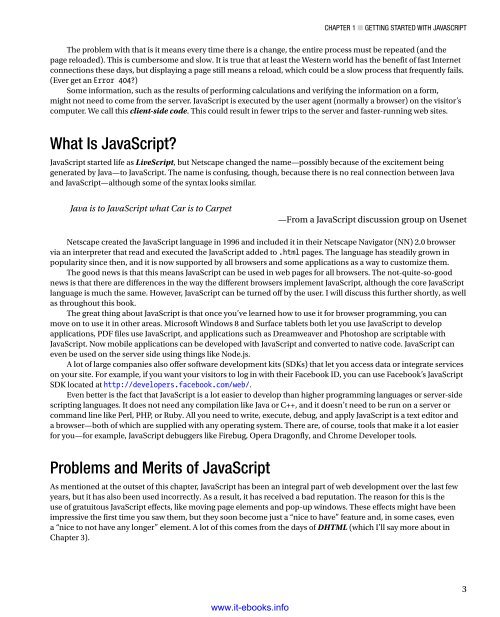Beginning JavaScript with DOM Scripting and Ajax, 2nd Edition
Create successful ePaper yourself
Turn your PDF publications into a flip-book with our unique Google optimized e-Paper software.
Chapter 1 ■ Getting Started <strong>with</strong> <strong>JavaScript</strong><br />
The problem <strong>with</strong> that is it means every time there is a change, the entire process must be repeated (<strong>and</strong> the<br />
page reloaded). This is cumbersome <strong>and</strong> slow. It is true that at least the Western world has the benefit of fast Internet<br />
connections these days, but displaying a page still means a reload, which could be a slow process that frequently fails.<br />
(Ever get an Error 404?)<br />
Some information, such as the results of performing calculations <strong>and</strong> verifying the information on a form,<br />
might not need to come from the server. <strong>JavaScript</strong> is executed by the user agent (normally a browser) on the visitor’s<br />
computer. We call this client-side code. This could result in fewer trips to the server <strong>and</strong> faster-running web sites.<br />
What Is <strong>JavaScript</strong>?<br />
<strong>JavaScript</strong> started life as LiveScript, but Netscape changed the name—possibly because of the excitement being<br />
generated by Java—to <strong>JavaScript</strong>. The name is confusing, though, because there is no real connection between Java<br />
<strong>and</strong> <strong>JavaScript</strong>—although some of the syntax looks similar.<br />
Java is to <strong>JavaScript</strong> what Car is to Carpet<br />
—From a <strong>JavaScript</strong> discussion group on Usenet<br />
Netscape created the <strong>JavaScript</strong> language in 1996 <strong>and</strong> included it in their Netscape Navigator (NN) 2.0 browser<br />
via an interpreter that read <strong>and</strong> executed the <strong>JavaScript</strong> added to .html pages. The language has steadily grown in<br />
popularity since then, <strong>and</strong> it is now supported by all browsers <strong>and</strong> some applications as a way to customize them.<br />
The good news is that this means <strong>JavaScript</strong> can be used in web pages for all browsers. The not-quite-so-good<br />
news is that there are differences in the way the different browsers implement <strong>JavaScript</strong>, although the core <strong>JavaScript</strong><br />
language is much the same. However, <strong>JavaScript</strong> can be turned off by the user. I will discuss this further shortly, as well<br />
as throughout this book.<br />
The great thing about <strong>JavaScript</strong> is that once you’ve learned how to use it for browser programming, you can<br />
move on to use it in other areas. Microsoft Windows 8 <strong>and</strong> Surface tablets both let you use <strong>JavaScript</strong> to develop<br />
applications, PDF files use <strong>JavaScript</strong>, <strong>and</strong> applications such as Dreamweaver <strong>and</strong> Photoshop are scriptable <strong>with</strong><br />
<strong>JavaScript</strong>. Now mobile applications can be developed <strong>with</strong> <strong>JavaScript</strong> <strong>and</strong> converted to native code. <strong>JavaScript</strong> can<br />
even be used on the server side using things like Node.js.<br />
A lot of large companies also offer software development kits (SDKs) that let you access data or integrate services<br />
on your site. For example, if you want your visitors to log in <strong>with</strong> their Facebook ID, you can use Facebook’s <strong>JavaScript</strong><br />
SDK located at http://developers.facebook.com/web/.<br />
Even better is the fact that <strong>JavaScript</strong> is a lot easier to develop than higher programming languages or server-side<br />
scripting languages. It does not need any compilation like Java or C++, <strong>and</strong> it doesn’t need to be run on a server or<br />
comm<strong>and</strong> line like Perl, PHP, or Ruby. All you need to write, execute, debug, <strong>and</strong> apply <strong>JavaScript</strong> is a text editor <strong>and</strong><br />
a browser—both of which are supplied <strong>with</strong> any operating system. There are, of course, tools that make it a lot easier<br />
for you—for example, <strong>JavaScript</strong> debuggers like Firebug, Opera Dragonfly, <strong>and</strong> Chrome Developer tools.<br />
Problems <strong>and</strong> Merits of <strong>JavaScript</strong><br />
As mentioned at the outset of this chapter, <strong>JavaScript</strong> has been an integral part of web development over the last few<br />
years, but it has also been used incorrectly. As a result, it has received a bad reputation. The reason for this is the<br />
use of gratuitous <strong>JavaScript</strong> effects, like moving page elements <strong>and</strong> pop-up windows. These effects might have been<br />
impressive the first time you saw them, but they soon become just a “nice to have” feature <strong>and</strong>, in some cases, even<br />
a “nice to not have any longer” element. A lot of this comes from the days of DHTML (which I’ll say more about in<br />
Chapter 3).<br />
www.it-ebooks.info<br />
3






